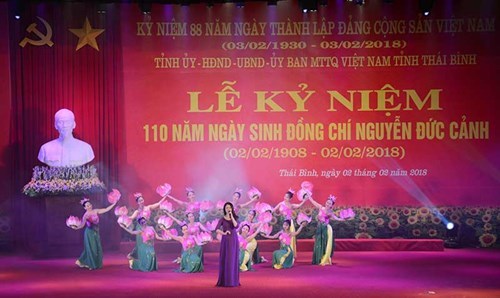    |
 |
|
General Secretary Nguyen Phu Trong and veteran communists at the ceremony. Photo: qdnd.vn |
The ceremony was attended by General Secretary of the Communist Party of Vietnam (CPV) Nguyen Phu Trong, Chairman of the CPV Central Committee’s Inspection Commission Tran Quoc Vuong, Secretary of the Hanoi Party Committee Hoang Trung Hai, representatives from some central agencies and localities as well as the family of the late leader, among others.
Addressing the event, Secretary of the Thai Binh Party Committee Pham Van Sinh reviewed the revolutionary life of the late communist.
Canh was born on February 2, 1908 in Diem Dien village, in today Thai Thuy district of Thai Binh.
Being enlightened by the revolutionary ideology, he joined various patriotic movements in 1925-26 when he was studying in Thanh Chung Nam Dinh High School. Then he joined the Vietnam Youth Revolution Association, which was a turning point in his revolutionary life.
In 1928, he was assigned to work as Hai Phong Party Secretary. In 1929, the working class movement had developed well and Canh had made lots of contribution to Tong Cong Hoi Do Bac Ky (the predecessor of the Vietnam General Confederation of Labor).
    |
 |
|
Art performance at the ceremony. Photo: qdnd.vn |
In March 1929, at House No.5D, Ham Long street of Hanoi, the first Communist unit in Vietnam was established with eight members including Canh.
In June 1929, he was elected to be a provisional member of the Central Committee of the Indochina Communist Party.
In April 1931, he was captured by the French. Though he was tortured by the invaders, he did not reveal any secrets of the Party. He was sentenced to death by the French and was killed in 1932.
Sinh said that as part of efforts to inherit and promote patriotism tradition of the ancestors, Thai Binh has overcome various difficulties and challenges to gain outstanding achievements in all fields.
He pledged that Thai Binh authorities will continue working hard to strengthen solidarity, and optimizing potentials and strengths of the province to build a locality of sustainable development, prosperity and civilization.
Source: VNA